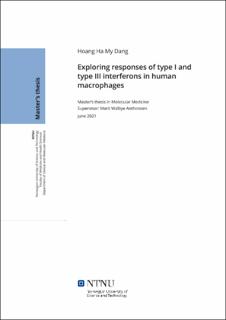| dc.description.abstract | Interferons are antiviral cytokines induced during viral infection. Type I and III IFNs are thought to share some of the same transcriptional outputs, yet some biological responses are distinct. IFN-λ receptor (IFNLR1) expression is not ubiquitous like the type I receptor and is strongly expressed in epithelial cells such as the respiratory tract and intestine. The molecular mechanisms underlying the different biological effects and cell-specific responses of type I and type III IFN are poorly understood. The extent to which type III IFNs can affect immune cells is controversial. This work aimed to investigate if human primary monocyte-derived macrophages (MDMs) express IFNLR1, whether IFN-λ1 induces antiviral and innate immune genes, and has antiviral activity against respiratory virus human metapneumovirus (HMPV) and its IFN-λ1 effects depend on IFNLR1 in MDMs. We found that type III IFNs were induced in response to HMPV infection in MDMs. Also, we found that human MDMs exhibit higher expression of both sIFNLR1 and mIFNLR1 compared with the analyzed epithelial cell types. At 24 hours post-exposure, pretreatment with type III reaches maximal ISG induction earlier than IFNs type I. 48-hour pretreatment with type I IFNs and III is able to reduce HMPV replication after 48-hour infection. Our result showed that type I and III IFNs induce a similar subset of ISG genes, but with differences in potency and kinetics. Type III IFN is slower and weaker in ISG induction, and could be less inflammatory and may provide therapeutic benefits with fewer side effects compared to type I IFN. siRNA-mediated reduction of IFNLR1 level significant suppress Viperin expression with concomitant increase in CXCL-10 and inflammatory cytokine IL-6. Also, we found that the JAK/STAT inhibitor Ruxolitinib can inhibits IFN-λ1-induced ISG pathways in human MDMs. Collectively, these results suggest that human MDMs express a functional IFNLR1. | |
